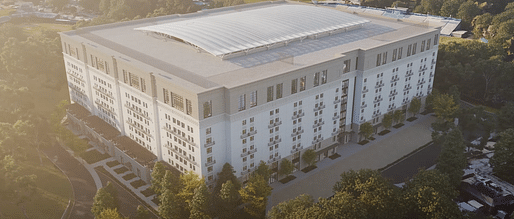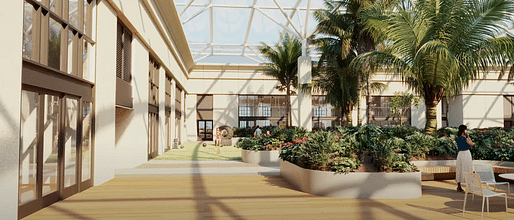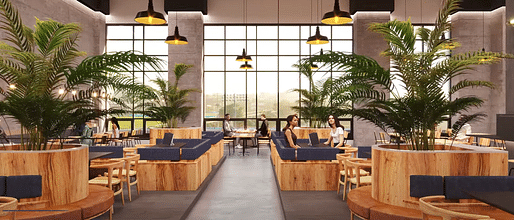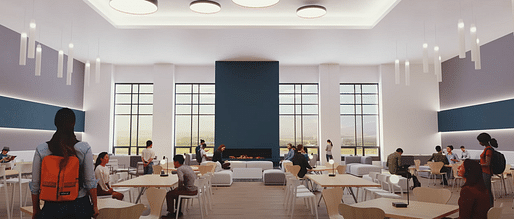
New details have emerged of the controversial Munger Hall student accommodation planned for the University of California, Santa Barbara. The updated scheme has seen two levels removed from the original design, from eleven to nine stories.
The changes come as UCSB prepares to submit an Environmental Impact Report for the development before approval is sought from the University of California Board of Regents and the California Coastal Commission.

As reported by The Daily Nexus, UCSB’s student-run newspaper, the university’s initial plan to commence construction on the project in late 2023 has now been removed. If construction were to begin in 2023, a projected 40-month construction program would see the building open in 2026.

“We do not have a target to start construction at this time,” a UCSB representative told the newspaper. “It will all depend on the ongoing process, including filing the EIR and other necessary approvals. At this point, if everything happened smoothly, the earliest that construction could start would be the summer of 2023, but we are still taking community input and do not want to get out in front of the process.”

As a result of the two-story reduction in height, the scheme will now provide 3,500 student beds as opposed to the originally-planned 4,536. According to the university, the revision is in part due to a reduced demand following the construction of other student accommodation projects nearby, and in response to “input from our community about the size and density” of the proposed plan. The university also cited a wish to avoid “potential issues related to airport traffic” as a reason for the reduction.

The project was initially unveiled in October 2021 and sought to provide over 4,500 student dorm rooms inside an eleven-story, 1.68 million-square-foot structure. The national spotlight was first placed on the initiative as a consequence of the resignation of architect Dennis McFadden from the USCB’s Design Review Committee over the proposal. With 94% of student bedrooms not providing access to natural light, one architecture critic branded the scheme a “jail masquerading as a dormitory.”

The architectural community also voiced fierce criticism, with eight former UC campus architects publishing a letter in opposition to the proposal. In December 2021, AIA Los Angeles issued an open letter to the university opposing the plan on behalf of its 4,500 members, following a similar move by AIA Santa Barbara. In June 2022, students from the university staged a public forum showcasing research-based alternatives to the scheme.

UCSB has made several moves to justify the scheme, including a Q+A released in November 2021 and a full-scale physical mock-up opened in June of this year. The development is also backed by billionaire Charles Munger, whose name is attached to the endeavor following his $200 million donation to the university. Munger was reported to have stipulated that his plan for the building be followed without alteration in return for the donation.

9 Comments
I hate the juice bar most of all.
Deranged people with enough money and power get to do whatever they want.
Munger made the offer in 2016, when he said the dorm would not have windows and that "I can do this better if I make it a couple stories taller.”
https://www.independent.com/20...
And the plan was five years in coming? With the projected 2026 completion date unlikely, that makes 10+ years without a solution to UCSB's housing crisis. It's not clear if any serious alternatives were ever considered.
Critics were left to wonder exactly which two floors were being removed.
And shorter doesn't make it good, just a little less bad.
Less is more. In the case of Munger Hall, nothing is better.
Wow, inflation bites so they decide to cut a couple floors but I an not sensing it addressing anything that had been pointed out. Cutting two floors doesn't eliminate the hazards that had been pointed out. Oh well.... apparently it's more a response to inflation. Maybe if inflation spikes and they need to cut the size to 1/3 the footprint or the project is cancelled. Then a newer and nicer student housing solution can be developed.
With more curriculum that can be taught online/remotely and degree programs with a hybrid formula on in-class and remote delivery of courses, we can potentially reduce number of classrooms and potentially reduce influx of housing demand and even if the housing demand is still increasing, we can potentially do partial conversion of the academic buildings where some classroom units become student housing units and some potential housing-studio units. Then there is also some potential for some faculty/staff housing as well to be addressed in the overall picture.
also, despite how much better the windowless dorm rooms are purported to be they failed to make a single appearance in the marketing video lmao.
Maybe they want it to be a surprise.
Block this user
Are you sure you want to block this user and hide all related comments throughout the site?
Archinect
This is your first comment on Archinect. Your comment will be visible once approved.